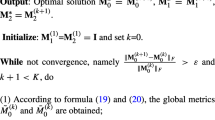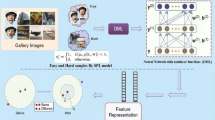Abstract
Metric learning for hierarchical classification is a significant problem whose purpose is to learn more discriminative metrics by exploiting the dataset’s hierarchical structure and achieving higher accuracy rates for hierarchical classification. However, most of the existing hierarchical metric learning methods fail to consider the irrelevance between the metrics of sibling nodes in a hierarchical tree, which makes the metric of each node not well distinguish child nodes. This paper proposes a hierarchical metric learning model based on intra-level and inter-level regularization. The model mines the idiosyncrasies of sibling nodes and learns a more discriminative metric for each non-leaf node. At the same time, by exploiting the commonalities of parent-child nodes to control inter-level error propagation. Extensive experiments on five hierarchical datasets demonstrate that the proposed algorithm can perform better than the existing ones.




Similar content being viewed by others
Explore related subjects
Discover the latest articles and news from researchers in related subjects, suggested using machine learning.References
Esuli A, Fagni T, Sebastiani F (2008) Boosting multi-label hierarchical text categorization. Inform Retrieval 11(4):287–313
Zheng Y, Fan JP, Zhang J, Gao XB (2017) Hierarchical learning of multi-task sparse metrics for large-scale image classification. Pattern Recognit 67:97–109
Wang HX, Shen XT, Pan W (2011) Large margin hierarchical classification with mutually exclusive class membership. J Mach Learn Res 12:2721–2748
Lv XM, Duan FJ (2018) Metric learning via feature weighting for scalable image retrieval. Pattern Recognition Letters, 109(JUL.15):97–102
Martinel. N (2018) Accelerated low-rank sparse metric learning for person re-identification. Pattern Recognition Letters, 112(SEP.1):234–240
Gundogdu B, Bianco MJ (2020) Collaborative similarity metric learning for face recognition in the wild. IET Image Process 14(9):1759–1768
Lebanon G (2006) Metric learning for text documents. Pattern Anal Mach Intell 28(4):497–508
Xing EP, Ng AY, Jordan MI, Russell (2002) SJ Distance metric learning with application to clustering with side-information. In Advances in Neural Information Processing Systems, pages 505–512
Weinberger KQ, Saul LK (2009) Distance metric learning for large margin nearest neighbor classification. J Mach Learn Res 10(1):207–244
Cover TM, Hart PE (2003) Nearest neighbor pattern classification. IEEE Trans Inform Theory 13(1):21–27
Davis JV, Kulis B, Jain P, Sra S, Dhillon IS (2007) Information-theoretic metric learning. In Int Conf Mach Learn 227:209–216
Chen S, Luo L, Yang J, Gong C, Li J, Huang H (2019) Curvilinear distance metric learning. In Advances in Neural Information Processing Systems, pages 4225–4234
Chen QN, Sun SL (2010) Hierarchical large margin nearest neighbor classification. In International Conference on Pattern Recognition, pages 906–909
Lei H, Mei KZ, Xin JM, Dong PX, Fan JP (2016) Hierarchical learning of large-margin metrics for large-scale image classification. Neurocomputing, 208(oct.5):46–58
Goel A, Banerjee B, Pizurica A (2018) Hierarchical metric learning for optical remote sensing scene categorization. IEEE Geoscience and Remote Sensing Letters, pages 1–5
Zheng Y, Fan JP, Zhang J, Gao XB (2020) Exploiting related and unrelated tasks for hierarchical metric learning and image classification. IEEE Trans. Image Process 29:883–896
Miller GA (1995) Wordnet: a lexical database for English. Commun Acm 38(11):39–41
Li LJ, Wang C, Lim Y, Blei DM, Li FF (2010) Building and using a semantivisual image hierarchy. In Computer Vision and Pattern Recognition, pages 3336–3343
Bengio S, Weston J, Grangier D (2010) Label embedding trees for large multi-class tasks. In Advances in Neural Information Processing Systems, pages 163–171
Liu BY, Sadeghi F, Tappen MF, Shamir O, Liu C (2013) Probabilistic label trees for efficient large scale image classification. In Computer Vision and Pattern Recognition
Fan JP, Zhou N, Peng JY, Gao L (2015) Hierarchical learning of tree classifiers for large-scale plant species identification. IEEE Trans Image Process 24(11):4172–4184
Gretton A, Bousquet O, Smola AJ, Schölkopf B (2005) Measuring statistical dependence with hilbert-schmidt norms. In Algorithmic Learning Theory 3734:63–77
Parameswaran S, Weinberger KQ (2010) Large margin multi-task metric learning. In Proceedings of Advances in Neural Information Processing Systems, pages 1867–1875
Ding CHQ, Dubchak I (2001) Multi-class protein fold recognition using support vector machines and neural networks. Bioinform 17(4):349–358
Wei LY, Liao MH, Gao X, Zou Q (2015) An improved protein structural classes prediction method by incorporating both sequence and structure information. IEEE Trans Nanobioscience 14(4):339–349
Dimitrovski I, Kocev D, Loskovska S, Dzeroski S (2011) Hierarchical annotation of medical images. Pattern Recognit 44(10–11):2436–2449
Everingham M, Gool LV, Williams CKI, Winn JM, Zisserman A (2010) The pascal visual object classes (VOC) challenge. Int J Comput Vis 88(2):303–338
Lampert CH, Nickisch H, Harmeling S (2009) Learning to detect unseen object classes by between-class attribute transfer. In Computer Vision and Pattern Recognition, pages 951–958
Acknowledgements
This work is supported by the National Key Research and Development Program of China (No.2019YFE0118200), the National Natural Science Foundation of China (Nos.61976184, 61772323), and the 1331 Engineering Project of Shanxi Province, China.
Author information
Authors and Affiliations
Corresponding author
Additional information
Publisher's Note
Springer Nature remains neutral with regard to jurisdictional claims in published maps and institutional affiliations.
Rights and permissions
Springer Nature or its licensor holds exclusive rights to this article under a publishing agreement with the author(s) or other rightsholder(s); author self-archiving of the accepted manuscript version of this article is solely governed by the terms of such publishing agreement and applicable law.
About this article
Cite this article
Li, L., Li, T., Wei, W. et al. Hierarchical metric learning with intra-level and inter-level regularization. Int. J. Mach. Learn. & Cyber. 13, 4033–4042 (2022). https://doi.org/10.1007/s13042-022-01664-x
Received:
Accepted:
Published:
Issue Date:
DOI: https://doi.org/10.1007/s13042-022-01664-x
Keywords
Profiles
- Wei Wei View author profile
- Jiye Liang View author profile




